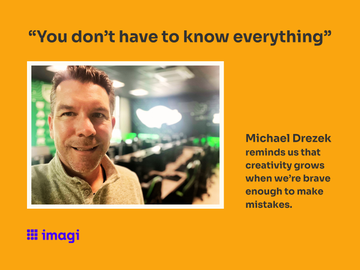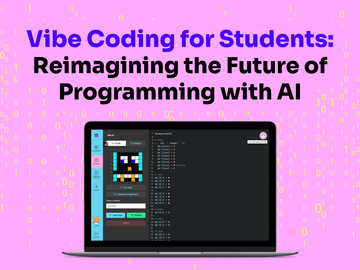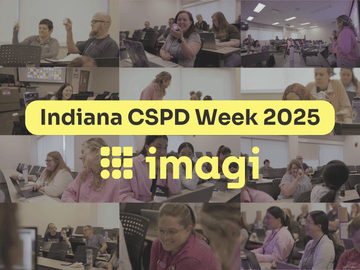Coding Confidence: How Michael Drezek Makes Computer Science Click for Every Student
Oct 14, 2025

When I spoke with Michael Drezek, he was sitting in a room that looked more like a futuristic arcade than a classroom. The walls of Lake Shore Central’s esports lab glowed with LED lights and monitors, the hum of computers cutting through the quiet. “We run our esports stuff out of here,” he said, gesturing behind him. “We even have an iRacing simulator in the back.”
The classroom hums like a LAN party turned art studio. It’s hard not to imagine the effect this has on a student walking through the door; curiosity first, confidence soon after. That same mix of curiosity and confidence defines how Michael teaches computer science, especially when he’s using imagi to help students turn code into something creative, personal, and expressive.
From Biology to Bytes: A Teacher Who Never Stopped Learning
Michael didn’t set out to be a computer science teacher. He started as a biology major, then switched to computer science, then to math. “I kept bouncing between things I was curious about,” he said. “But the thread was always problem-solving.”
After a decade teaching math, he became the district’s go-to tech coach, the person teachers called when a new device or idea landed on their desks. “Once New York rolled out the computer science and digital fluency standards, I went all in,” he explained. “I got certified, and now I co-teach AP Computer Science and lead game design and media tech classes.”
That mindset, curiosity first, credentials later, is exactly what he tries to model for his students. “Sometimes with tech, you don’t have to know everything,” he said, smiling. “You just jump in.”
Discovering imagi: Curiosity Meets Creativity
Michael first encountered imagi at a conference. “I was just wandering through the vendor hall, and the blinking lights caught my eye,” he said. “It looked creative, like anyone could do it.”
He later connected with imagi’s team in Sweden and got support from his administrators to run a pilot. What hooked him wasn’t just the concept but the experience. “The onboarding materials were phenomenal,” he said. “I went through the slide decks, tried it myself, and thought, okay, I can teach this. It’s approachable.”
That ease of entry matters. For Michael, every teacher needs to see themselves as a learner first. “You don’t have to be the expert in the room,” he said. “You can discover alongside your students.”

Inside the Classroom: From Intimidation to Aha
A typical imagi lesson in Michael’s classroom starts simple: basic shapes, colors, and commands. He introduces the website and gets students exploring before they even touch the physical charms. “I wanted them to see what was possible, to get that spark first,” he said.
At first, students were hesitant. “They looked at the code and thought, this is going to be hard,” he recalled. “But once they got their first little pixel pattern to work, they had that aha moment. Suddenly, it wasn’t scary. It was fun.”
That’s when the magic happens. The room fills with the sound of collaboration, kids leaning over to help each other debug and laughing when they forget a bracket, celebrating when the LED charm lights up just right. “I actually hope they make mistakes,” Michael said. “Because when they figure it out, they own it.”
He often pairs students to encourage communication and problem-solving. “In AP Computer Science, we talk about pair programming and debugging,” he said. “But even younger students can get that, it’s real-world collaboration.”
Beyond Coding: Creativity as a Life Skill
When you ask Michael what skills imagi really builds, he doesn’t start with syntax or loops. He starts with creativity.
“Creativity is one of the top skills the world needs, but it’s not a class you can sign up for,” he said. “In K–12, we have to nurture it. imagi brings that out naturally.”
He sees it in the projects students dream up, when a simple heart animation becomes a lightning bolt, or when a static image evolves into motion. “There’s no grade for creativity,” he said. “But you see it in their faces when they make something that’s theirs.”
And as students experiment, they learn more than just code. They learn how to communicate ideas, work together, and stay resilient when things don’t work right away. “That’s what I want them to take with them,” he said. “Not just how to code but also how to create.”
Coding for Everyone: Making Space for Every Student
Michael is quick to highlight imagi’s inclusivity. “In my AP Computer Science class, I have one girl and seven boys,” he said. “We need more girls in coding, it’s as simple as that.”
That’s why imagi’s mission resonates with him. “It’s fun, it’s approachable, and it helps every student, especially girls, feel like they belong in computer science,” he said. “I love that imagi’s mission is to get more girls into coding, while still being something every student can enjoy, no matter their background.”

Advice for Teachers: Start with Curiosity, Not Perfection
For teachers who want to bring coding into their classrooms, Michael’s advice is simple: play.
“Just play around,” he said. “Don’t be afraid to not know. Try a lesson, use the resources, find a partner, and learn together.”
He also recommends joining professional communities like CSTA, where educators share ideas and resources. “There’s so much out there,” he said. “You just have to be willing to explore.”
If you’ve ever thought coding was too complex to bring into your classroom, maybe start where Michael did; with curiosity, not certainty. Open imagi Edu, try a lesson, and see what happens. You might just find your own aha moment waiting to light up the room.



